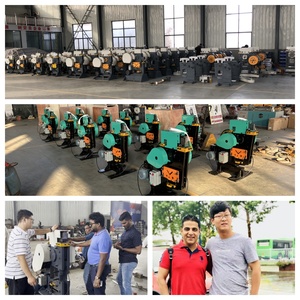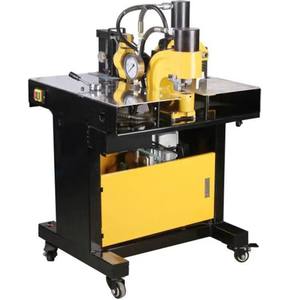
All categories
Featured selections
Trade Assurance
Buyer Central
Help Center
Get the app
Become a supplier

(6651 products available)


























A China busbar machine fabricates busbars used in power distribution and transmission. These machines come in various types, each performing a specific operation on the busbar. Some popular types of Chinese busbar machines include cutting, punching, bending, shear, drilling, and notching machines.
Busbar Cutting Machine
Users operate a busbar cutting machine manually or automatically to cut busbars to size. This machine typically has stops and gauges that set the length of the cut. The cutting component may be a shearing blade, a saw, or laser technology, depending on the design.
Busbar Punching Machine
Using a busbar punching machine allows users to create holes in previously cut busbars. These holes accommodate mounting or wire connections. The punching machine has an electric motor that provides power and multiple dies. Each busbar design requires a specific hole pattern, diameter, and size.
Busbar Bending Machine
A busbar bending machine allows operators to create angles and curves in the busbar to meet specific installation requirements. The bending machine uses hydraulic or mechanical force to bend the busbar without compromising integrity. It may have dedicated fixtures and gauges to provide accurate and repeatable bends.
Busbar Shearing Machine
A busbar shearing machine cuts the busbar to length and provides a square or straight edge. This helps simplify the mounting process. Shearing machines cut the busbars in a single motion using a blade. The busbar shearing machine has major components like a blade, ram, and table.
Busbar Notching Machine
The role of a busbar notching machine is to cut notches in a busbar. These notches are used in various applications where there is a need for a change in the busbar profile or to accommodate other components.
Busbar Drilling Machine
Using a busbar drilling machine helps operators to create holes in the busbars for mounting or connections. It also facilitates the fabrication of busbars that require multiple holes for busbar to busbar connection.
These machines require routine maintenance in order to ensure their excellent performance. Regular maintenance can help prevent breakdowns, reduce repair costs, and extend the lifespan of the machines. The following are some general maintenance tips:
HVAP:
Hyperbaric Busbar machines are used in HVAP (high voltage alternating current) transmission lines to make high voltage busbars. The entire HVAP system conveys huge amounts of electricity using huge busbars, connecting many units.
Automobiles:
In one car, there are many electronic parts, such as batteries, motor drive systems, etc. All these need one electric power runtime system to give power. Hence, automobile busbars play a big role in connecting the power sources of one vehicle.
Data centers/computers:
Data center devices and computer systems have many components that require electrical connections. Using busbars can supply a large amount of power that is evenly distributed to each piece of gear.
Solar panels:
Solar panel busbars play a role in connecting the electric current produced by the individual panels so that it can be exported as usable electric power.
When choosing a busbar fabrication machine, it is essential to consider a few things. It will help one select a machine that will satisfy the needs of the intended consumers.
Q1: Which industries use busbar machines?
A1: Several industries use busbar machines, such as electrical and power transmission, commercial building infrastructures, data centers, metal fabrication, automotive, aerospace, military and defense, public transit and bus manufacturers, renewable energy, and research and academic institutions.
Q2: What is the trend of the busbar machine market?
A2: The global busbar machine market is growing. The development of urban infrastructure and the increasing demand for renewable energy are propelling the market. With rapid urbanization and population growth, the need for efficient power distribution systems is rising, boosting the demand for busbar machines.
Q3: How long does busbar processing take?
A3: The busbar machine improves the processing speed of busbars. The time depends on several factors such as the size, design complexity, and quantity of the busbars. Generally, if setting up and waiting for the next processing are not included, cutting a busbar takes about 2-3 minutes. Holes drilling takes about 3-4 seconds for each hole, and bending takes about 2-3 minutes for each bend.